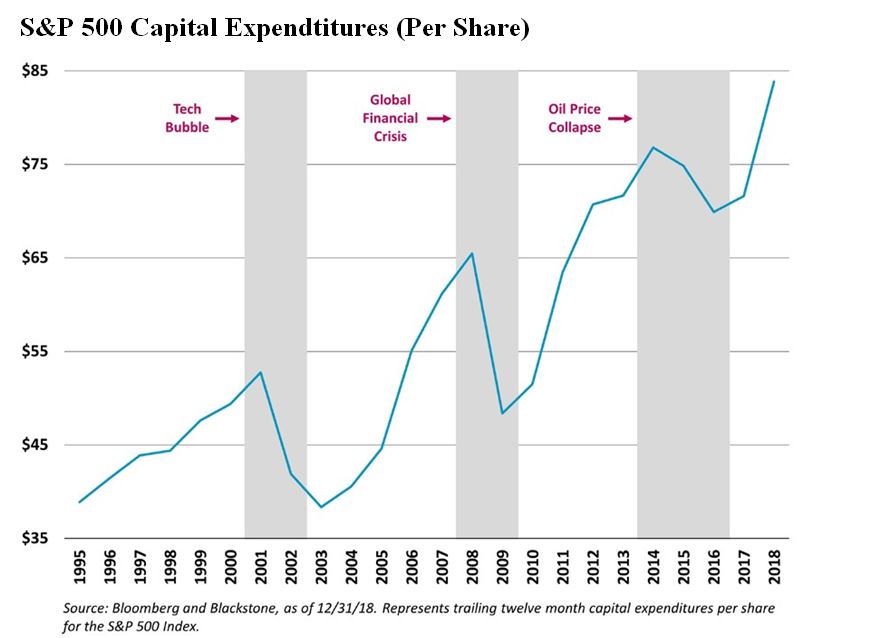Joe Zidle: Technology: The New Destination for Capex


By Joe Zidle, Chief Investment Strategist
with Taylor Becker, Research Analyst
In our 10 Surprises of 2019, we noted that growth would not come from typical sources. Generally speaking, the consumer drives growth during the first half of a recovery and businesses take over in the second half. At this point in the current cycle, investors might expect companies to turn their attention from M&A and share buybacks to plants, property and equipment capex. In fact, companies are beginning to shift their focus and invest for growth—but this time it looks different.
Cyclicals suffer when capex slows The US experienced a manufacturing recession in 2015 as oil prices plummeted, from $115/bbl in mid-2014 to below $30/bbl in early 2016. Capex had been on the rise, but companies were quick to shelve spending plans. Cyclical sectors (ex-energy) underperformed defensives by 12.7% on average during this period, with earnings growth 5.4% lower.1 The industrials and materials sectors were especially hurt, returning -3.0% and -19.4%, respectively.2 For comparison, the overall index was positive over this period.
S&P 500® capex at 25-year high Capital spending shows signs of recovery with S&P 500 capex at its highest levels in decades. More broadly, nonresidential private investment grew by 7% year-over-year in 2018. This is more than double the average annual growth rate since 2000, and well above the 4.5% average rate for the past 50 years.3 Further, many of Blackstone’s portfolio companies continue to increase their capex plans. Based on our most recent CEO survey, more firms plan to increase capex spending than reduce it, and this difference became even more positive in the most recent quarter.4

Companies are solving for people Notably, capital flows look different today because companies need solutions for a shortage of workers. For example, Blackstone owns approximately a hundred portfolio companies, collectively employing about 500,000 people at virtually all skill levels. In our internal surveys, the ability to hire qualified workers is the top concern for many of our CEOs.4 Labor markets are at the tightest levels in generation, and companies need to find new ways to boost productivity.
They’re not solving for production Companies don’t need to increase production capabilities. From the 1960s until 2008, the US economy grew at an average real rate of approximately 3.1%. Since 2008, that growth rate has been closer to 2%. As a result of that slower growth, capacity utilization rates are below their 50-year average of 80.
Enter, software and R&D Today, companies prefer to increase productivity through technology. Since 2002, private investment in intellectual property products (e.g., software and R&D) has grown at a faster rate than other types of capex spending.3 This trend has only accelerated since 2015. Companies may struggle to fill job openings, but they can invest in new technologies to increase the efficiency of their existing workforce.
Capex winners: Cyclicals and tech Cyclicals (ex-energy) have outperformed defensives by over 28% since the US emerged from the manufacturing recession in 2016.5 Technology has led the way, outperforming the other cyclical sectors by 34%.5 Business confidence is necessary for capex spending to continue, though. Protracted trade disputes, government dysfunction, anti-growth policies and a global slowdown are a few factors that could cause companies to stop spending for growth. However, positive outcomes for any or all of these factors could result in upside for capex—and for the sectors that benefit from it. Such outcomes could also reinvigorate the last leg of this cycle.
1. Source: Bloomberg and Blackstone. Based on total return gross dividends and trailing 12-month earnings per share of the S&P 500 from 7/1/2014—1/31/2016. Sector comparisons exclude the communications (due to recent reclassification) and energy sectors.
2. Source: Bloomberg and Blackstone. Based on total return gross dividends of the S&P 500 materials and industrials sectors from 7/1/2014—1/31/2016.
3. Source: Bureau of Economic Analysis and Blackstone, as of 12/31/18. Based on compound annual growth rate of real gross private domestic investment: fixed investment: nonresidential. Data series not seasonally adjusted.
4. Based on surveys of a subset of Blackstone’s corporate private equity portfolio companies, as of 12/31/2018.
5. Source: Bloomberg and Blackstone. Based on total return gross dividends for the S&P 500 from 2/1/2016—2/28/2019. Sector comparisons exclude the communications (due to recent reclassification) and energy sectors.
* * * * *
The views expressed in this commentary are the personal views of the author and do not necessarily reflect the views of The Blackstone Group L.P. (together with its affiliates, “Blackstone”). The views expressed reflect the current views of the author as of the date hereof and Blackstone undertakes no responsibility to advise you of any changes in the views expressed herein. For more information about how Blackstone collects, uses, stores and processes your personal information, please see our Privacy Policy here: http://go.pardot.com/e/213192/privacy/5qvg1/159241904?h=DLDMCKk_gbLh-dwf0GzGHhVUEfnqCWBvZMKqJJTvPOo. You have the right to object to receiving direct marketing from Blackstone at any time. Please click the link above to unsubscribe from this mailing list.
Blackstone and others associated with it may have positions in and effect transactions in securities of companies mentioned or indirectly referenced in this commentary and may also perform or seek to perform services for those companies. Investment concepts mentioned in this commentary may be unsuitable for investors depending on their specific investment objectives and financial position.
Tax considerations, margin requirements, commissions and other transaction costs may significantly affect the economic consequences of any transaction concepts referenced in this commentary and should be reviewed carefully with one’s investment and tax advisors. All information in this commentary is believed to be reliable as of the date on which this commentary was issued, and has been obtained from public sources believed to be reliable. No representation or warranty, either express or implied, is provided in relation to the accuracy or completeness of the information contained herein.
This commentary does not constitute an offer to sell any securities or the solicitation of an offer to purchase any securities. This commentary discusses broad market, industry or sector trends, or other general economic, market or political conditions and has not been provided in a fiduciary capacity under ERISA and should not be construed as research, investment advice, or any investment recommendation. Past performance is not necessarily indicative of future performance.



